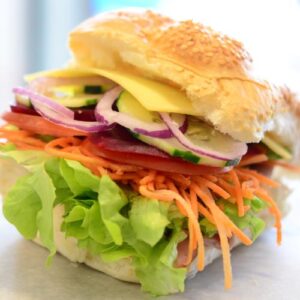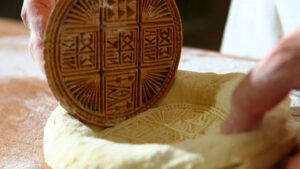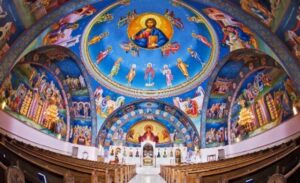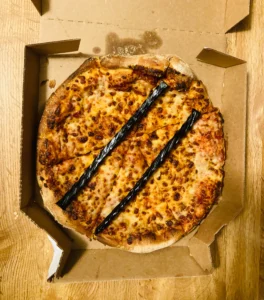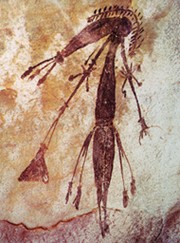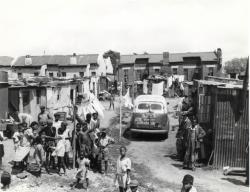Queen Elizabeth II
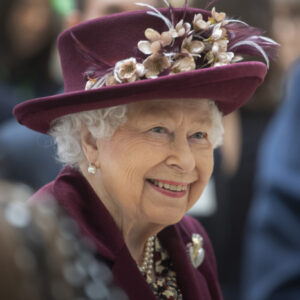 Her everlasting legacy. She did not linger. She died with dignity. She would have ensured that.
Her everlasting legacy. She did not linger. She died with dignity. She would have ensured that.
Celebrate her life; not mourn. She would not have wanted the clocks to stop.
Reflection
I reluctantly must accept that I have a form of long COVID-19. It is September; I reverted from a positive to negative RAT in second week in July. My condition is characterised by persistent productive cough, lack of sleep, a veil of depression. Some days are better; some I relapse.
In any event:
The window exists at the end of the room A discoloured pane frames the tree Sallow maple leaves cling Potted cymbidiums hang From trunks That gently swing defiantly green Striving to touch the cycadic spikes Along the unseen cobblestone path The gate aubergine and fire-bricked wall Brown-wooded letter box All separates me from the World Nothing else? That’s right Nothing else Why bother? I do not go out Just lean back in my chair And realise that Winter has come.

I wrote the above which I called “Reflection”. It is this view which I see every day from my table, where I sit behind my computer. To my right is the television screen – images bouncing around as the sound is turned off. I love flowers and now on the table to the right of my direct gaze is a bunch of garnet-coloured dianthus (Sweet William) in a muted patterned rosé vase. It is framed by an arced spike of cymbidium flowers – carmine stigma and delicate red russet petals – cut from our garden – stuck in a Tall Poppy Vase, that someone gave me some years ago.
Yes, this past week was my Australia Day – September One – the start of seasonal regeneration and when the wattles are at their zenith. I will get out of my chair and go out. Maybe I shall improve, but it is draining me.
Fishing traps
Rain is a myth haunting the arid places
And clouds are the dry eyelashes of the sun and moon. . ..
Its only protest is dust and the rivers drying
And the horrid gaping sores of a dying race – Maria Reay, Poem from Brewarrina (1946).
I was reminded of one of my visits to Brewarrina by my son meeting “Dean from Brewarrina”, in the Tasmanian Highlands for God’s sake. We are a literary family, but predominantly in the lifestyle area of writing. Maybe I stray when I comment about the fish traps on the Barwon River at Brewarrina, a very old manifestation of Australian Aboriginal identity and industry.
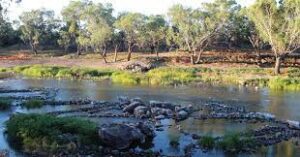
The poet, Mary Gilmore, grew up in the Riverina and moved around NSW as a child. Her father if not a sundowner, was certainly a wanderer. Mary Gilmore herself moved around and was one of a group which followed William Lane to Paraguay in 1893 to found the settlement of New Australia to pursue a socialist ideal. Hers was a short lived emigration; nevertheless, she lived her life back in Australia with her exquisite literary ability used to promote her socialist ideals.
In 1933, when she was 56, she wrote about the fishing traps in an article in the Sydney Morning Herald, the following of which is an extract:
That the aborigines made fish-traps and fish-balks (as we used to call them when we came across them) is a fact. That they used natural barriers as Mr David G Stead writes is also a fact. Sixty years ago there were many of the smaller balks in existence, and white people knew them and made use of them for other purposes than those intended by the aborigines. The larger fish-traps were made for the great gatherings, and were invariably based on a running reef or natural outcrop of rock. There were a number of these places of gathering known to my people, and I often heard them spoken of. One of these was on the Clarence, one at Brewarrina, one on the Upper Murray, and one down near Hay or Narrandera – it was near the swamps between these two places, the swamps being sanctuaries.
When you view the fishing traps on the Barwon River at Brewarrina, there is a necklace of rocks meandering down the river, and when Gilmore was writing her articles, she was responding to opinion which tended to dismiss these traps as manmade. Gilmore concedes in this paragraph that the local indigenous people used natural rock formations upon which to fashion their fish traps. The reason that few have survived is attributed to whitefella dismantling the structures; but another reason is that all the structures as described, particularly those made of wood and reeds, would have been susceptible to the periodic flooding of the Murray-Darling Basin.
The reason for the survival of the Brewarrina fish traps was the fact that Brewarrina was beyond the navigability of the river paddle steamers. However, the structures are simple and could have been easily reconstructed by tribal groups after every river catastrophe, because the river is susceptible to spreading across the floodplains. Brewarrina may have these rapids, where rocks are suitable for re-arrangement, but it emphasised the importance of Brewarrina as a gathering place for Aboriginal tribes. These corroborees required some preparation to ensure sufficient food was available. Hence the importance of ensuring the fish traps were in good condition; but the converse may be true. For a hunter gatherer society where the corroboree was a regular convocation of the local tribes, it was essential to hold them in a place where food was plentiful.
One of the observations about the necklace of rocks defining the fish traps was that each fish trap is said to have one family responsible for its trap. Given the nature of Aboriginal society, I find it unusual that, in this instance, each of the fish traps was singled out as a single family’s responsibility, implying that the fish traps conferred de facto property rights.
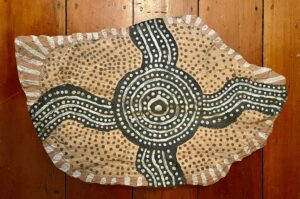
Brewarrina has an Aboriginal Cultural Museum recessed into a hill, and one day when driving between Bourke and Walgett, we dropped by. I remember this day well. I had no intention of purchasing anything – after all it was a museum. Nevertheless, there was one item for sale and that was a slab of sandstone upon which a depiction of the Brewarrina fishing traps was painted in ochre. The cost was $250. We bought it.
It was a very heavy piece. We transported it back to Sydney, where it sits on its mulga wood stand. We also picked up a large rock, which sat at the intersection of two sandy tracks just outside the Tilpa pub. The rock squats incongruously in the front garden, a desert souvenir in a sub-tropical mess of bromeliads. Both remain as treasured memorabilia from the Outback.
The fish trap painting was something special – whether the fish traps were nature’s work, manmade or shared between both, it does not matter. What is not debated is that Brewarrina has been a place of significance to the Aboriginal people, even now the site of the annual Baiame’s Ngunnhu Festival, belying the misery implicit in the words of dispossession written by Maria Rey nearly 80 years ago.
Utopia
Now
We seek constitutional reforms to empower our people and take a rightful place in our own country. When we have power over our destiny our children will flourish. They will walk in two worlds and their culture will be a gift to their country – Uluru Statement 2017
Then
The objectives of ATSIC are:
- to ensure maximum participation of Aboriginal and Torres Strait Islander people in government policy formulation and implementation
- to promote indigenous self-management and self-sufficiency
- to further indigenous economic, social and cultural development, and
- to ensure co-ordination of Commonwealth, state, territory and local government policy affecting indigenous people. – Section 3 of the Aboriginal and Torres Strait Islander Commission Act 1989.
By way of
“Where a clan or group has continued to acknowledge the laws and (so far as practicable) to observe the customs based on the traditions of that clan or group, whereby their traditional connection with the land has been substantially maintained, the traditional community title of that clan or group can be said to remain in existence.” – Attachment by certain High Court Judges to the Mabo decision
Once I was invited to address a bunch of Aboriginal elders at Utopia. This settlement is home to both the Alyerrerre and Anmatyerre people. It lies 350 kilometres north-west of Alice Springs on the Sandover Highway, an unmade road which runs across the Northern Territory spinifex and black soil plains until it eventually joins the Camooweal-Urandangi Road just over the Queensland border.
Utopia had even earned a reputation as a centre for Aboriginal art, being where Emily Kame Kngwarreye lived and painted. When we visited, she had passed away three years before. She was one of a number of Utopia artists, notably Minnie Pwerle, Barbara Weir and Gloria Petyarre.
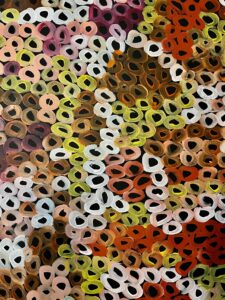
As I was undertaking work for the Commonwealth Government, the Aboriginal elders, an all-male group, invited me to tell them why I was there. They had moved to a roofed, open concrete area, and then they squatted in a semi-circular area. A whitefella, to whom I had not been introduced hung onto a pole on the fringe.
Even though the Aboriginal elders had seemingly sat in a non-hierarchial arc it was not difficult to work out who was the boss. As I started to talk, I started to experience this extraordinary energy of the gathering. I had never felt this level of non- verbal communication, despite their expressions being impassive, as I glanced down and around the group.
In retrospect, I likened it to the same pressure I had felt at school, when you had to speak for two minutes, without saying “um” or “ah” – or repeat yourself. The pressure was constant during the 15 minutes I spoke. When I finished, the man whom I had already identified as the leading elder stood up and said, half to the meeting in general and half to me. “Very good meeting. Let’s go have a cup of tea.” That was that.
I had felt the communication during my time talking; it had been intense, continuous but not hostile. Over the mug of tea, the discussion was general. One indication of whether you, the whitefella, was acceptable was the ability to chat. Aboriginal people can be silent; and if they believe it to be irrelevant, they simply don’t turn up for a meeting. I have been snubbed several times; “sorry business” takes precedence.
This time the two women in the party then joined us for tea. The centre of attention was the young kid with a charred kangaroo head which he gnawed at distractedly. It is amazing how small instances stick in one’s memory when other parts of that weekend passed in a blur.
The women went off with the women elders for “women’s business”. I have no idea what went on, even though one of the women was my wife. So, I can say no more; but if you are a woman reader, then you can find out if you wanted to do so.
But what is then the “Voice” in Canberra whitefella terms?
This was just one of my experiences with Aboriginal people. These were essentially desert people, and a significant group. It emphasised to me something that I had come to realise – the level of non-verbal communication among Aboriginal people. There was no indication of how well the two tribes intersected. In modern settlements where tribes have been forced together, such as Doomadgee in the Gulf Country. This product of the mission supervision and education led to displacement from traditional lands. Doomadgee is now a cauldron of various tribal groups forced together. Unsurprisingly, they are often in physical conflict.
Therefore, the concept of Voice has different connotations.
William Buckley escaped from a failed white settlement in Victoria in 1802 and lived for over 30 years with the Aboriginals who inhabited the land around Port Phillip Bay and thence into the hinterland where Colac and the shallow Western district lakes are located. When he emerged from the bush at the time Batman came from Tasmania to settle Melbourne, he had lost the ability to speak English.
Nevertheless, he had a unique perspective on what constituted communication. “Voice” in terms of a continuous Aboriginal traditional means of communication has always had a huge component of the non-verbal but also the song lines.
Buckley quickly regained his use of the English language, and in his memoirs, he describes his original exposure to a corrobborree (sic). These seemed to be where tribes could meet in harmony or for a celebratory purpose. When he was picked up by the Wathaurong tribe, as white was associated with death, he was thought of being a re-incarnated relative. So his “initiation” into the tribe was the reason for a corrobborree (sic) where there were hours of dancing and singing and beating of sticks and improvised drumming by the women on their skin rugs which they had removed and tightened between their knees to resemble a primitive tympanum. This gave meaning to the Voice?
Then one Aboriginal fellow, whose family were from Queensland, demonstrated that in his tribe there were clicks in his language. At least there is one Aboriginal voice, known as Lardil, where the clicks express a certain meaning. He demonstrated the clicks.
I had experienced a click language before, in Namibia among those from the Kalahari Desert people. In fact, where we were once in Namibia I asked one of the women serving us to read out the menu in her language. A wondrous experience – words mingled with clicks. I regret that I did not record her recitation.
Above I mentioned songlines. I remember the small group of Aboriginals, whom we once encountered on the banks of the Murray River near Mildura. They had come from the Pitjantjatjara Lands to get away from the “troubles” as they said. These people live in the northern part of South Australia, but they have a number of what I thought were songlines which they can follow across “country”. After all, I had also met a group of Pitjantjatjara men in Ceduna on the Southern Australian Coast, an eight day walk across the desert from Amata, one of the Pitjantjatjara settlements. It was suggested that this small group on the Murray River may have followed other songlines, as one Aboriginal man later suggested. Unlikely, but then these people do travel – and it is their land as they would have it.
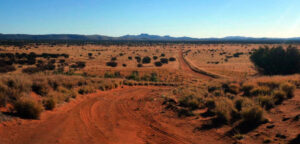
Songlines are events where fact merges with myth interpreted through storytelling, rock art, songs and dance. As one Aboriginal elder has said: “Aboriginal people use songlines as a means of navigation, following all the landmarks they sing about. You may not have been there, but the songs give you enough information to find your way. Our people learn hundreds of songs.”
Thus, there are many interpretations of “Voice”; the Aboriginal people have so many languages and so many different totems and taboos to augment the various voices.
Given that, I have no idea what the Voice means. Is it just a forum for the articulate Aboriginal, given that there have been a number of these manifestations?
The sorry history of the Aboriginal and Torres Islander organisation (ATSIC) failed the Voice test. ATSIC was defunded nearly 20 years ago; and the former Chair is still facing 380 fraud charges. This miserable outcome of ATSIC is being used by opponents of enshrining a Voice. What has changed?
My vote in any referendum is contingent that its interpretation does not enshrine an Indigenous elite. Not the shrill Voice of self-importance. Secondly, nor should the Voice be a nod to tokenism.
The dulled Voice of dispossession continued.
Jobs and Skills Summit
We hardly need to labour the importance of the AMA’s core purpose—fighting for doctors’ interests—amid the chaos COVID continues to inflict on a health system that was stretched and inefficient to begin with. It is true that doctors’ interests have rarely, if ever, perfectly aligned with the public interest. Nonetheless, the debate over the future of healthcare in Australia stands to benefit from coherent and unified advocacy on behalf of the medical profession. The AMA still has political clout, but it needs a renewed clarity of purpose to more convincingly argue that doctor knows best
Thus concluded an editorial that appeared in the Sydney Morning Herald in July bemoaning the lack of engagement and the fall in the influence of a once powerful Australian Medical Association. In 1983 I attended the Hawke summit as part of the invited Association delegation, where the AMA President spoke.
It is important to reflect on how important the Hawke Government Summit was. It was summarised thus:
The Hawke Labor Government has not been conspicuous for its reforming pro-labour initiatives. With the exception of Medicare (itself quite a limited initiative) little has been done to improve the position of the least well off members of the population. This is not to say that the Labor Government has done nothing and is not interested in reform. It is just a question of the reforms they have introduced: assets tests, the deregulation of banking, entry of foreign banks, abolition of exchange controls and the floating of the Australian dollar.
The “relevance symbolism” of AMA involvement was not lost on some of the more assertive members of the AMA, but the following years were full of fighting for doctors’ interests. Whether the SMH editorial writer above was referring to the rise of Bruce Shepherd and his protégé, Brendan Nelson in the late 1980s I’m not sure. Certainly, the last bilateral Inquiry into Fees for Medicare Benefit occurred in 1984. Thereafter relations between government and the AMA dissolved into conflict.
Influence has faded once the strategists, who facilitated the AMA presence at that 1983 Summit, moved on and it lost its strategic direction under the populist Shepherd and his acolytes. Shepherd may have won a few battles, but an association where office holders are ephemeral loses continuity, (especially when they pursue personal agendas rather than those of the Association) – and may I say clout.
The AMA was not invited by Albanese’s crew to the recent summit. In fact, there appear to be only three invitees associated with health – Annie Butler; Federal secretary of the Australian Nursing and Midwife Association; Carmel Monaghan, CEO Ramsay Health; and Christine Nixon, Chair of the Australian College of General Practitioners.

One was a health professional, Annie Butler, heading 290,000 nurses – an experienced nurse; one businesswoman heading a successful private health group and an ex-copper who has had her fair share of controversy. Given the politics of general practice, as distinct from the practice of general practice, who knows what her grasp of the health sector is apart from the petty intrigue which has dogged the RACGP for years.
The effect of the pandemic on employment seems to be ignored in the lack of AMA representation at the Summit last week. Although the AMA had made plenty of comment, it failed to have a leading role. In fact, it was one of the failures of organised medicine that it assumed a passive role and at no stage attempted to co-ordinate resources and advice outside government during 2020-2022.
Such intervention would have shown relevance and helped quell extreme opinions. A very small but vocal minority in the community seized the agenda; and the politicians had no defence except enforced social isolation. This was an important incentive for vaccination when it had become available, but once the lock downs were revoked, there was no other incentive to maintain the level of vaccination, which had been further complicated by the different times of the approval for administration to the various age groups. Their public health experts were silenced.
Medical associations now have lay administrators. Their loyalty is to their career. They have no ongoing professional stake in maintaining the professional relevance with government.
As one who has led a number of campaigns, notably the campaign against the French nuclear tests in the South Pacific in the 1990s, I eschewed the self-aggrandisement for action. We had a plan. Irrespective of its effect, France has long since stopped the nuclear tests. The lesson was that when the interests of the medical profession coincide with those of the public as it did then, it is a powerful combination.
An AMA which exists with its office-bearers counting the number of the media releases and their appearance on Tik Tok or whatever – but in effect doing nothing or as one person said using the phrase “looking good in their suits” to define inactivity. That unfortunately is the AMA, a sound bite expressing concern or saying why doesn’t the government do something is in itself a recipe for irrelevance.
It is not surprising that Annie Butler has the ear of Government. She is an experienced nurse. She does not have to look good in a suit.
Mouse Whisper
Overheard in a lunch bar
Sandwich maker: What would you like in your salad roll?”
She: Everything except onion, please.
He, in American accent (next in line): That is a very Australian way of ordering.
She: Is it? Never really thought about it. Still, better than saying tomato… and a slice of beetroot … carrot … lettuce yes… jalapeño… perhaps jack cheese… at least with using “except” I’ve avoided the list sliding into infinity!
He: I get your meaning. So different from us Americans.
Whisper: The efficient quiet Australian!
